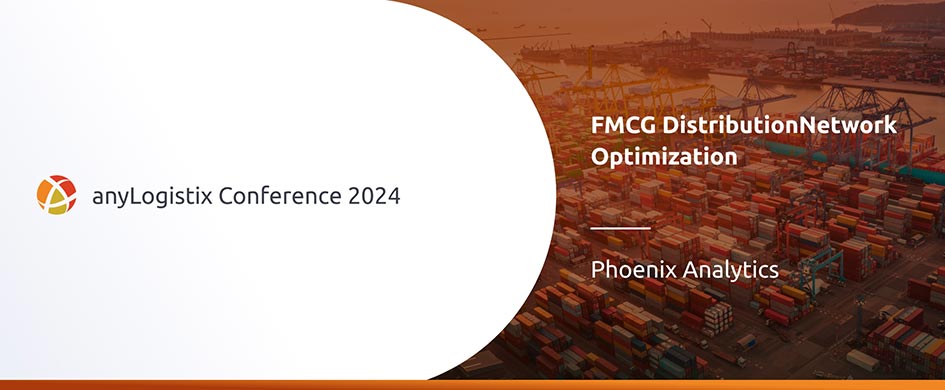Widely known companies like Coca-Cola, Deloitte, and Danone use anyLogistix to optimize their supply chains. Have you tried it already? If not, download our free version and try it for yourself today!

This blog post is partly based on the presentation by Phoenix Analytics at the anyLogistix Conference 2024.
It often feels like magic how quickly our favorite snacks, cleaning supplies, and personal care products are restocked on store shelves. They might not appear the exact moment the last one is taken, but it's still impressive. In reality, it isn't magic; it's the art of masterfully managed supply chains in the FMCG (fast-moving consumer goods) sector.
In this blog post, we will cover how companies make decisions critical to the production of these items and their inventory without overfilling warehouses or emptying shelves. Join us as we explore some of the best practices—from choosing the right plant for the right customer to managing FMCG inventory efficiently.
Contents:
According to SAP, strategic sourcing simply optimizes the supply chain, helping businesses reduce their expenses and cut down on risks coming from suppliers. In other words, it enables the business to predict costs and future needs clearly.
At its core, strategic sourcing in the supply chain helps managers make smart choices about suppliers so that every dollar spent becomes an investment in more predictable and cost-effective supply outcomes. The approach considers not just the immediate needs but also the long-term implications of the decisions for the business.
Strategic sourcing in FMCG does not focus on identifying the source with the least cost; it means using the whole network to most effectively meet customer requirements. One of the main targets is to determine which customer is better served by which plant, specifically in a large geographic area with several delivery locations.
This problem may appear to have an easy answer: serve every customer from the closest plant. Unfortunately, it is not that simple. Production capacity limitations, the need to fill delivery trucks efficiently, different production costs at different locations—all these complicate the choice. Sometimes, it is less expensive to serve a customer from a distant plant with lower production expenses, even when transportation costs are high.

Effective inventory management is important for balancing stock costs with the need to meet fluctuating consumer demand. In scenarios of low demand, FMCG companies often follow a make-to-stock strategy in readiness for high-demand phases of their product life cycle.
Advanced technologies, like supply chain digital twins, enable companies to simulate stock needs and run different FMCG inventory management strategies to optimize stock levels while reducing costs.
Aligning strategic sourcing decisions with stock optimization can lead to improvements in supply chain performance. For example, understanding the interplay between where products are sourced and where they are stored can minimize overall costs and increase logistical effectiveness.
For instance, a case study by a FMCG company operating across Turkey illustrates the benefits of this integration. The consulting company used a sophisticated sourcing matrix to reduce costs by identifying the right plants for each customer.
They considered factors like transportation, available capacity at plants, and inventory costs. This strategy not only reduced transportation expenses by about 10% but also facilitated more informed decisions regarding new production facilities.
You can watch the full report on this case, presented by anyLogistix partner, Phoenix Analytics.

Now let’s imagine you have a supply chain, and you want to find the exact answer for your specific situation. For instance, the one we already discussed: which customer should be served by which plant? Well, you have two choices:
Technology is especially important when it comes to refining the operational activities of the FMCG supply chain. By using anyLogistix with customized constraints and scenario analysis, companies can react quickly and make informed decisions. The software helps streamline operations with detailed sourcing strategy insights within the supply chain and inventory management.
With anyLogistix, you can test different supply chain scenarios, detect the most cost-effective sourcing options, and optimize your stock levels to balance demand and avoid overstocking.
Widely known companies like Coca-Cola, Deloitte, and Danone use anyLogistix to optimize their supply chains. Have you tried it already? If not, download our free version and try it for yourself today!

Operational excellence for companies goes along with the integration of supply chain strategic sourcing and effective FMCG inventory management. With the help of anyLogistix, an end-to-end supply chain management approach can minimize costs and simultaneously improve operational efficiency.
In this blog post, we covered some of the best practices for strategic sourcing. We also discussed the significance of making informed decisions today, such as determining which plant should serve which customer.
Now you know how well-managed stock levels can drive supply chain efficiency. It is the strategic integration of these components that forms the basis of an operational and cost-effective supply chain in the FMCG sector.
In addition, discover our case studies section. There, you will find a lot of useful information on how leading companies use anyLogistix in their supply chain optimization projects.